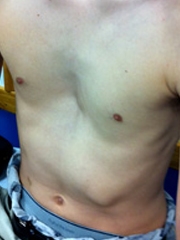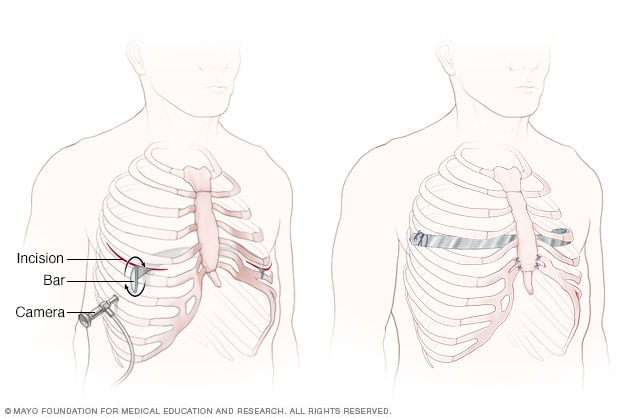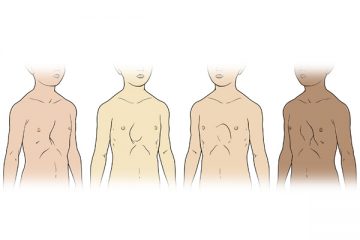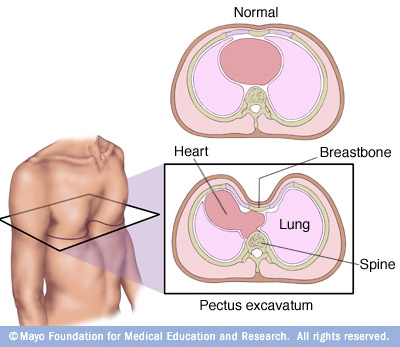pectus excavatum baby surgery
Severe pectus excavatum may cause problems with the heart and lungs. The depression may be in the center of the chest or more pronounced on one side asymmetrical.

Pectus Excavatum Children S Hospital Of Philadelphia
About the Nuss Procedure The Nuss procedure involves two small incisions made on each side of the chest.

. We may recommend observation for mild to moderate cases and surgery for more severe or complex cases. At this time surgery is the only option that works. Our surgery team has seen hundreds of children with pectus excavatum and can help you decide the best options for your child.
After surgical correction of the pectus excavatum we were able to construct a sternum by incising the lateral border of each sternal bar thereby creating flaps that we sutured together at midline. For children who need surgery we almost always place a bar inside the chest to push up on the indented breastbone. Adults have either had to live with it or face major more complicated operations.
You may also hear the terms saucer-shaped horns of steer or elongated used to describe the condition. It occurs mostly in boys and frequently more members in a family are affected. The goal of surgery to correct a pectus excavatum defect is to improve breathing posture and cardiac function in addition to giving the chest a normal appearance.
One out of 400 babies is born with a chest wall that doesnt form properly and becomes concave. At the time of surgery an epidural catheter will be placed in your childs back for continuous local anesthesia and will stay in place for several days. Our patient was a 13-year-old girl whose case was particularly unusual because of the association of sternal cleft with pectus excavatum.
Patients that have severe symptomatic PE are offered Minimally Invasive Repair of Pectus Excavatum MIRPE. Kids with pectus routinely have surgery. Pectus Excavatum Surgical Repair.
Kids with mild pectus excavatum who arent bothered by their appearance and dont have breathing problems typically dont need treatment. At Childrens Hospital Col. The deformity of pectus excavatum is caused by a negative pressure in the anterior mediastinum sucking in the body of the sternum.
Anesthesia and care at time of surgery. Our experts most often use the Nuss procedure which is a minimally invasive approach to repair pectus excavatum. The most commonly performed surgical treatment for pectus excavatum is the Nuss procedure This is a minimally invasive surgical procedure.
Pectus excavatum sometimes called cobblers chest sunken chest or funnel chest is the most common chest deformity and is caused when several ribs and the sternum grow abnormally which produces a caved-in or sunken appearance of the chest. The ideal age for surgical treatment of pectus excavatum is between 12 and 18 years. Pectus excavatum is a condition in which instead of being level with the ribs the breastbone sternum is sunken so that the middle of the chest looks caved in.
Surgeons at Texas Childrens generally perform a minimally invasive operation called the Nuss procedure to correct Pectus Excavatum. The surgical technique in children is similar to that of adults except for the higher forces involved that often necessitate sternal elevation and more involved stabilization strategies. Pectus excavatum is a condition in which the breastbone sternum of the chest is caved in.
There are several surgical options to correct pectus excavatum. Kids get it. Before the surgery your kid needs an Echo of the heart.
The surgery would be a metal bar behind the ribcage for a few years. Pectus excavatum may be mild or severe. Pectus Excavatum is a congenital condition that affects the sternum and ribcage which makes the center of the chest curve inward.
The Nuss procedure is a surgery to correct severe pectus excavatum. Pectus excavatum a deformity of the sternum and ribs caused by an unbalanced costochondral hypertrophy is a congenital abnormality with a prevalence of 1 per 1000 patients. The minimally invasive repair or Nuss procedure.
The open or modified Ravitch procedure. A baby playpen all can be useful spaces for the restricted time of recovery. This information from Great Ormond Street Hospital GOSH is about pectus excavatum also known as funnel chest.
Pectus excavatum or sunken chest is a depression in the chest. Two types of surgery are used. Your childs surgery will take place at Childrens Hospital.
This is called the Nuss procedure. Its where the breastbone sinks into the chest causing a. During this procedure small incisions are made on each side of the chest to allow the surgeon to insert a metal support bar underneath the sternum to reverse the depression in the chest.
1 2 Pectus excavatum may be associated with connective tissue disorders such as Marfan and EhlersDanlos syndrome. What Is the Nuss Procedure. The purpose of this is to look for valve problems that can be associated with pectus excavatum.
The surgical repair of pectus excavatum is a painful procedure. In some cases surgery can treat pectus excavatum. Fast Facts About Pectus Excavatum Repair Surgery.
Also known as sunken chest or funnel chest pectus excavatum can be corrected with the minimally invasive surgical technique called the Nuss procedure or with traditional open surgery known. If your childs condition needs medical help besides home treatment you and your doctor can choose surgery as one of the fixing solutions. In most cases surgery is not indicated.
Pectus excavatum is the most common congenital birth defect. Outpatient surgery and anesthesia can be uncomfortable painful. This is usually due to the heart.
Learn more about this condition and the treatments available. A child can be born with a pectus defect or develop it during. How Is Pectus Excavatum Treated.
The pectus excavatum repair is a surgery to fix the shape of the bone in the middle of the chest called the sternum or breastbone so that the lungs and the heart are not squeezed by the inward curve of the chest. Surgical Correction of Pectus Excavatum in Kids. Pectus excavatum a bone deformity where Ive of the bones in the chest grow inwards instead of outwards.
Pectus excavatum affects about one in 1000 children and is four times as common in boys as in girls. At CHOP we offer two different treatments for pectus excavatum. Pectus excavatum is an abnormal development of the rib cage in which the sternum breastbone grows inward resulting in a noticeable and sometimes severe indentation of the chest wall.
Pectus excavatum is an anatomical deformity of the chest wall that kittens and puppies are born with. During this operation a curved stainless steel bar is inserted in the chest through small incisions on either side and is guided between the sternum and the heart under direct visualization with a camera through a small incision just below the. Length of stay in the hospital is determined primarily by pain control.
This happens because several ribs and the breastbone grow abnormally. The treatment of pectus excavatum is dependent upon the severity of the defect and your childs symptoms. Its more commonly referred to as funnel chest.
This is typically accomplished by repositioning the breastbone.

Department Of Surgery Pectus Excavatum

Pectus Excavatum And The Nuss Procedure Youtube

Nuss Procedure For Pectus Excavatum Background Indications Contraindications

Department Of Surgery Pectus Excavatum

Pectus Excavatum Chest Wall Stanford Children S Health

Thoracic Surgery Program Johns Hopkins All Children S Hospital

Pectus Excavatum My Tips For Organizing Surgery And Finding An Insurance Cover Hubpages

Learning About Pectus Excavatum Repair In Children

Before And After Photos Nuss Procedure Chest Deformities Chkd

Pectus Excavatum Diagnosis And Treatment Mayo Clinic

Department Of Surgery Pectus Excavatum

History Of Pectus Excavatum Treatment Nuss Procedure Chkd

Pectus Excavatum Symptoms Treatments And Complications

Thoracic Surgery Program Johns Hopkins All Children S Hospital

Pectus Excavatum And Carinatum Repair Ucla Health

Pectus Excavatum Nuss Surgery Children S Health Orange County


/GettyImages-955109626-4b3292cc1af6404d8e85bd1145bd1193.jpg)